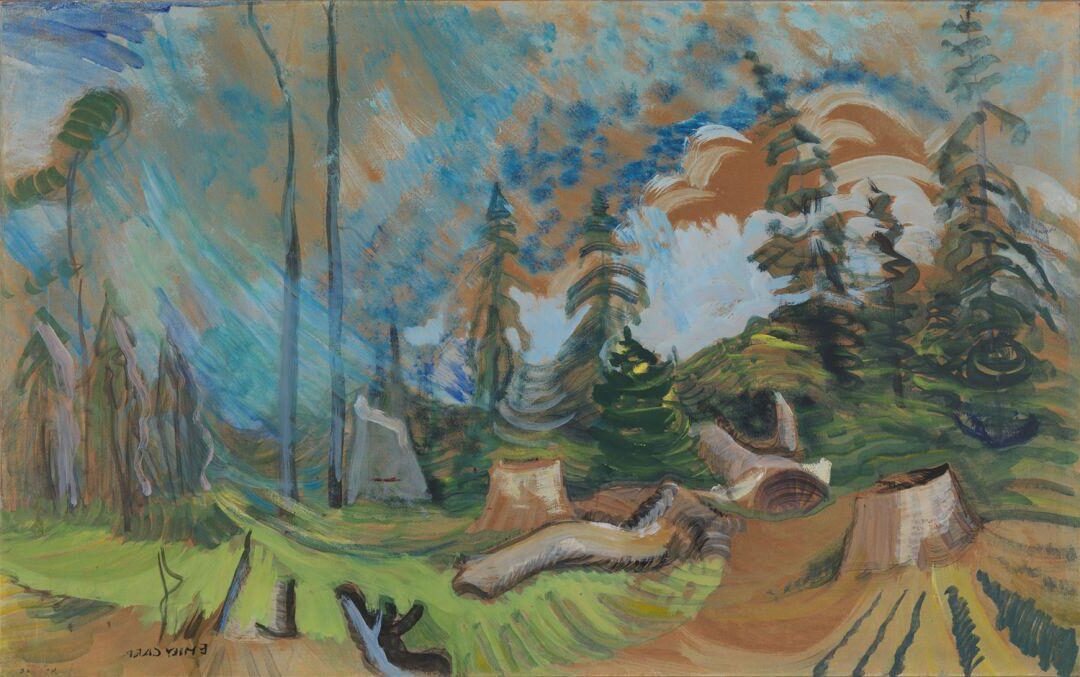Emily Carr Paintings: Exploring Canadian Art Heritage
Born: December 13, 1871, British Columbia, Canada
Death: March 2, 1945, British Columbia, Canada
Art Movement: Post-Impressionism, Modernism
Nationality: Canadian
Influenced By: Lawren Harris
Institution: San Francisco Art Institute (SFAI), San Francisco, and Westminster School of Art
Emily Carr Paintings: Exploring Canadian Art Heritage
Life and Legacy of Emily Carr
Emily Carr was born on December 13, 1871, and became a leading figure in Canadian art.

Odds and Ends (1939) by Emily Carr
She grew up on Vancouver Island in British Columbia, where the lush landscapes influenced her deeply. Her contact with Indigenous cultures and their art also left a significant mark on her work.
Carr’s paintings often featured the natural beauty of the region. British Columbia’s forests and seascapes came alive under her brush. Her unique style was both modern and deeply rooted in the spirit of the land.
The National Gallery of Canada houses some of her most celebrated pieces, showcasing her impact on Canadian art. Her works are also displayed at the Royal BC Museum, preserving her artistic legacy.
Klee Wyck, her first book, won the prestigious Governor General’s Award. Through her vivid writing, Carr captured the richness of her surroundings and thoughts.
1945 marked the end of Carr’s journey, but her influence continues. As a prolific Canadian artist, she inspired future generations to explore Canadian identity through art. Her contributions remain a crucial part of Canada’s cultural heritage.
Today, Emily Carr is celebrated as a true Canadian icon, revered for her dedication to capturing the essence of Canada’s wild landscapes and cultural diversity.
Significant Themes in Carr’s Art
Emily Carr’s art uniquely captures the essence of Indigenous cultures and the natural landscapes of western Canada. Her paintings convey respect for the traditions of First Nations peoples and their deep connection to the land.
Indigenous Peoples and Culture
Emily Carr’s work is deeply intertwined with Indigenous cultures of British Columbia. She often highlighted totem poles and other elements of Indigenous life.
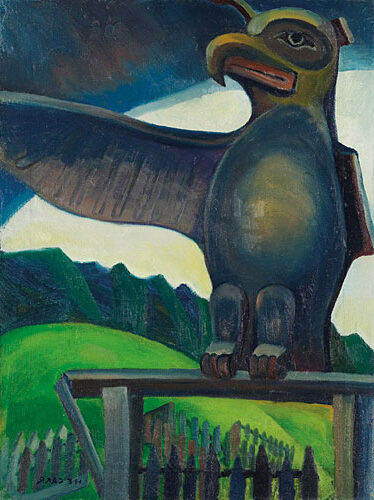
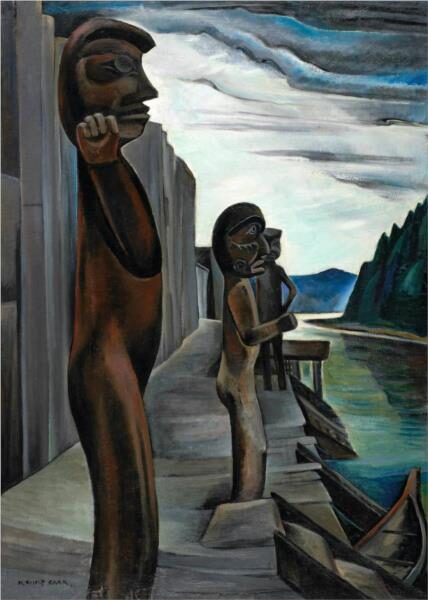
Her travels to places like the Queen Charlotte Islands, now known as Haida Gwaii, brought her in contact with the Haida, Gitxsan, Tsimshian, and Nuu-chah-nulth peoples.
Carr’s paintings provide a window into these cultures, despite challenges of cultural appropriation. Her respectful depiction of Indigenous themes reflects her admiration for these communities.
Her art offers insight into the social and spiritual aspects of their lives, emphasizing their cultural richness and traditions.
Landscape and Environment
The natural environment played a central role in Carr’s paintings. Her expressive landscapes captured the beauty and majesty of British Columbia’s forests and coastlines.
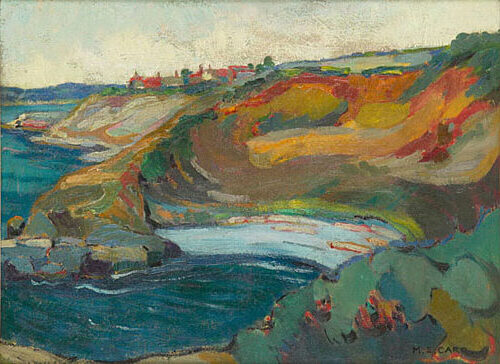
Chemainus Bay, Vancouver Island (1924–1925) by Emily Carr
She portrayed the intimate relationship between the land and its inhabitants, giving life to the sweeping views through vibrant colors.
Carr’s works often focus on the impact of human interaction with nature, subtly highlighting environmental concerns.
Her vivid depictions of the land parallel a growing awareness of environmental issues, placing her within a broader movement in Canadian art. These landscapes are more than just scenes; they communicate the profound connection between nature and culture.
Styles and Influences
Emily Carr was a remarkable figure in Canadian art, known for her unique blend of modern styles and deep appreciation for Indigenous art and landscapes. Her work captures the vibrant energy of the natural world and reflects the influence of different artistic movements.
Modernism and Post-Impressionism
Emily Carr’s art shows strong connections to Modernism and Post-Impressionism. She embraced these styles by experimenting with color, form, and perspective.
Her brushstrokes were bold and expressive, capturing the dynamic and dense landscapes of British Columbia.
Her use of a vibrant color palette is reminiscent of Fauvism, a movement known for its dramatic colors and emotional intensity.
Carr was influenced by the Group of Seven, particularly Lawren Harris, who introduced her to more abstract and modern techniques during her time in Eastern Canada. This led to a more dynamic style in her later works.
The Intersection of Canadian and Indigenous Art
Carr’s art reflects her lifelong commitment to portraying the culture and landscapes of Canada’s Indigenous peoples. She often visited Indigenous communities, learning from their cultural practices and art forms, which became central to her work.
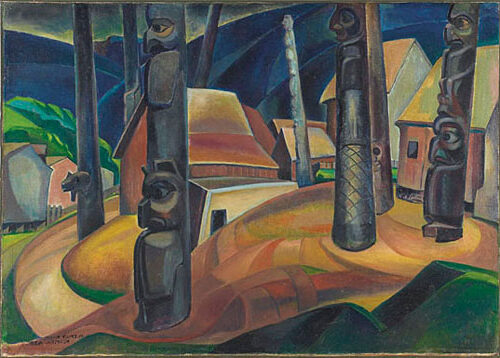
Kispiax Village (1929) by Emily Carr
Her paintings of totem poles and village scenes illustrate this deep respect for Indigenous artistry.
She blended these elements with her modernist approach, creating a unique fusion of styles.
Influenced by the Canadian Group of Painters, Carr sought to express the spirit of the Canadian landscape while paying homage to its earliest inhabitants.
This intersection created a distinct voice in Canadian art, setting Emily Carr apart as a pioneering artist who honored both the natural and cultural heritage of her country.
Carr’s Artistic Milestones
Emily Carr’s journey in art was marked by influential works and significant exhibitions. Her creative identity was shaped by embracing both modernist styles and traditional influences.
Major Works and Exhibitions
Emily Carr is renowned for several significant works, including The Indian Church, Big Raven, and Above the Gravel Pit. These paintings showcase her use of oil on canvas to capture the beauty and spirit of the landscapes and Indigenous cultures of the Pacific Northwest.


Her work in the 1930s, particularly around 1935, revealed her mastery of the medium. Totem Forest is another remarkable painting that displays her focus on Indigenous themes.
Carr was part of important exhibitions, notably at the Vancouver Art Gallery. These exhibitions played a crucial role in bringing her visionary art to a broader audience. Her association with contemporaries like A.Y. Jackson of the Group of Seven further established her reputation.
Formation of Artistic Identity
Carr’s artistic identity evolved through a blend of formal European art education and her deep connection to Canadian landscapes and Indigenous motifs.
Her modernist approach, evident in her later paintings, was influenced by exposure to post-impressionist styles.
Sketchbooks and journals played a vital role in documenting her artistic process and inspiration. These personal records show her thoughts and observations, helping to refine her distinctive voice in painting.
By merging vivid color palettes and dynamic compositions, Carr created a unique style that resonated with the cultural narratives of her time. Her pioneering spirit and dedication to exploring the essence of the Canadian wilderness and Indigenous heritage marked her legacy in the art world.
Preservation of Carr’s Oeuvre
The preservation of Emily Carr’s work is crucial for understanding Canadian art and history.
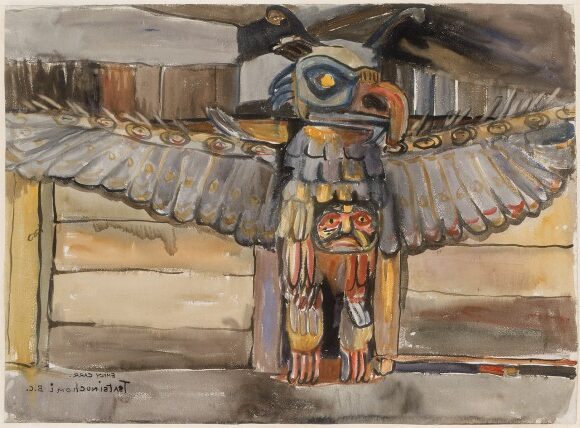
Tsatsisnukomi, B.C. (1912) by Emily Carr
The Royal BC Museum and BC Archives hold a significant collection of her original artwork, alongside letters, photographs, and sound recordings. These materials provide deep insight into Carr’s life and creative process.
The Art Gallery of Greater Victoria houses some of Carr’s treasured pieces. Other sketches, drawings, and prints are maintained by institutions such as the McMichael Canadian Art Collection.
Art conservators play a vital role in the care of Carr’s paintings. They protect the original materials from damage. Techniques include careful cleaning and restoration.
Conservators restore vibrancy and stability to her works, allowing future generations to appreciate them.
Modern technology assists in preservation. Digitization helps to catalog and store these valuable pieces.
Resources like the Google Cultural Institute provide digital access. This visibility ensures global appreciation of Carr’s artistic contributions.
Emily Carr’s artwork is exhibited in more than 35 galleries and museums worldwide. Her influence continues to inspire artists and art lovers. These preserved and digitized collections offer invaluable resources for learning and exploration.
Frequently Asked Questions
Emily Carr’s paintings capture the essence of the Pacific Northwest. Her works evoke interest due to their unique style and deep cultural themes.
How did Emily Carr die?
Emily Carr died on March 2, 1945, in Victoria, British Columbia. She suffered a heart attack.
Why are Emily Carr’s paintings so popular?
Carr’s paintings are popular for their bold colors and strong brushwork. They often depict the landscapes and indigenous cultures of the Pacific Northwest, offering both artistic beauty and cultural insight.
Where is the largest collection of Emily Carr paintings?
The largest collection of Emily Carr’s paintings can be found at the Royal BC Museum in Victoria, British Columbia. This museum hosts a significant number of her works.
What is the value of an Emily Carr painting?
The value of an Emily Carr painting can be very high. Her works have fetched record prices at auctions, sometimes selling for millions of dollars, depending on the painting’s significance and condition.
Can you purchase original Emily Carr paintings, and if so, where?
Yes, original Emily Carr paintings can occasionally be purchased through major auction houses like Sotheby’s and Christie’s. Private art dealers specializing in Canadian art might also have her work available.
What are some interesting facts about Emily Carr’s life and work?
Emily Carr was born in Victoria in 1871. She studied art in San Francisco and Europe. She struggled for recognition during her life. However, Carr is now seen as a key figure in Canadian art.

